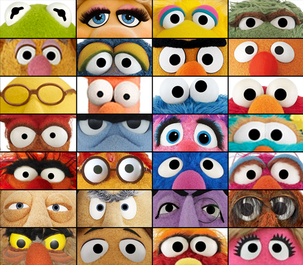Puppetry Resources and Information
Puppet types...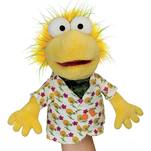 Wembley from "Fraggle Rock" Wembley from "Fraggle Rock"
(this list is not at all exhaustive)
HAND PUPPET: The hand puppet is the iconic "puppet" and is generally what people think of when someone mentions puppets. Hand puppets can be as simple as a sock puppet or as complex as one of Jim Henson's Muppets. Some examples of hand puppets used by Round Lake over the years are the Bluebird from "Shrek," Audrey 2 (pod 2) from "Little Shop of Horrors," and the Squirrels from "Willy Wonka." See the resources below for places to find great hand puppet patterns. 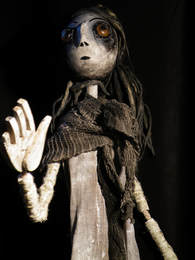
ROD PUPPET: A rod puppet is generally pretty simple and can be quite effective. With a rod puppet, the puppeteer holds a rod which controls head and body movements--often, a secondary rod (or a trigger) will be used to manipulate a mouth (As with our Audrey 2 pod 1). Rod puppets can have secondary rods to work arms or legs and can be as short as a few inches or 10s of feet tall as in large pageant puppets. 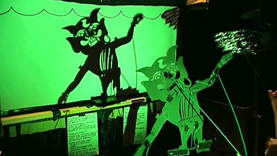
SHADOW PUPPET: A shadow puppet can be two or three-dimensional and generally has hinged parts that are manipulated by rods. The puppet is held between a light source (like a projector) and a translucent screen on which it casts a shadow. The size of the puppet can be manipulated by moving the puppet closer to the screen (a smaller shadow) or closer to the light source (a larger shadow). While shadow puppets are a standard part of various Asian traditional theatre (wayang kulit in Indonesia, Nang Sbek Thom, in Cambodia, and nang yai in Thailand) there are amazing examples of shadow puppets being used in a more modern context. Check out "Mr. and Mrs. Pennyworth" from Lookingglass Theatre in Chicago and "Feathers of Fire" at http://www.kingorama.com/feathersoffire/
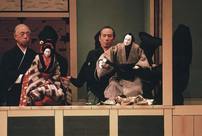
BUNRAKU: A form of Japanese puppet theatre where a single figure is manipulated by a team of three performers. This form of puppetry is used in the play "The Long Christmas Ride Home" by Paula Vogel.
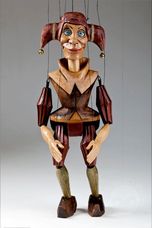
MARIONETTE: A marionette is any puppet whose main method of manipulation is through the use of strings. Because marionette's have a much more traditional or "old fashioned" connotation and have a very distinctive look when moved, they work best in simple storytelling (the lonely goatherd from "The Sounds of Music" or the prologue of "Once Upon A Mattress")
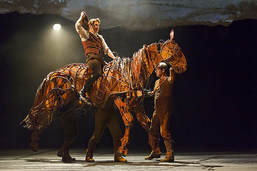 "War Horse" "War Horse"
BODY PUPPET: This puppet generally covers one or more bodies and is manipulated from the inside. The most common version of this is Big Bird from "Sesame Street" and Audrey 2 from "Little Shop of Horrors." This type of puppet is hugely popular in Jim Henson's movies and TV shows from the 1980s like Labyrinth, The Dark Crystal, and Fraggle Rock.
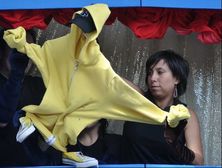
OBJECT PUPPET: An object puppet is any puppet made from found or everyday objects. This can also be a specifically constructed art object that is used as, or manipulated as, a puppet.
Resources...Here are some great resources on puppet building, history, and anything else I could find!
https://www.projectpuppet.com/--An amazing resource for all things puppet! http://puppetbuilder.com/info/index.html--Great puppet diagrams for first time puppet building. http://drama.uconn.edu/programs/puppet-arts/--University of Connecticut Puppetry program http://theatre.wvu.edu/academics/undergraduate/puppetry-West Virginia University Puppetry Program http://www.hensonfoundation.org/--The Jim Henson Foundation. Lots of information on contemporary puppet arts. https://www.puppeteers.org/discover-puppetry/other-resources/--Resources from the Puppeteers of America http://www.chicagopuppetfest.org/--The Chicago International Puppet Festival. This happens every two years and will occur again in 2019. |
Materials...A puppet can be made of nearly anything. That said, these are some of the things I use all the time when making puppets.
PVC pipe: This is cheap and provides great, light weight support for large scale puppets. Pageant puppets, giant rod puppets, and other large puppets often will use this. Check out the gallery below for a few examples. Urethane foam: This is the standard foam that Joann Fabrics, Hobby Lobby, and Michael's sells. It can be expensive, but a coupon does wonders. I typically use ½” or ¾” foam for the heads/bodies of hand puppets. RLHS’s Gingy was made with a piece of 2” foam. L200: L200 is an amazing foam that is similar to the Craft Foam sheets you can buy at craft stores. L200 is paintable (but needs to be sealed with modge podge), heat formable, carvable, and sandable (to an extent). It is great for armor, a puppet with a hard shell, and spikes/horns. Depending on the use, Craft Foam works just as well, but often only comes in 1/8” and ¼” sheets. L200 sources can be found in the resources below. Fleece—Muppets are often made with something called Antron fleece. This type of fleece is great because it is dyeable and, because it has a high pile, makes seams virtually invisible (when hand sewn). Unfortunately, this fleece is rather expensive and can be hard to come by. Fortunately, Blizzard fleece and anti-pill fleece from fabric stores works just fine. It can be stretched over many foam shapes relatively well and seams can be hidden with some practice. Other materials that are very handy to have are: Small hinges, small (strong) springs, rubber gasket (this is a small square of rubber found in the plumbing section of the hardware store), faux leather, feathers, hinges, springs, sculpey, paper clay, ping pong balls, foam golf balls, Nerf balls, and plastic spoons. (these last 4 can all be used to make eyes). Things to remember...Quicksand Effect:
This is when a puppet (particularly hand puppets) sink out of view due to a tired arm. How do you avoid this? Practice, practice, practice. Evita puppets/frozen arms Again, this is usually an issues with hand puppets with arm rods. When you gesture with the puppet's arm and forget to put it back into a resting position, they end up walking through a scene with arms out like Evita. How do you avoid this? Using a mirror practice finding the resting positions. Then, using a single gesture, work on making the gesture and resetting to your resting position. Where do I look? (puppet and performer) Remember, when using a puppet in a production (especially when you are visible as the puppeteer) to always look at the puppet. If you look at the puppet then the audience will look at the puppet. Lower Jaw/talking Your four fingers operate the top of the puppet's mouth and the thumb will operate the bottom part. When you make the puppet speak, make sure to only use the thumb to make the talking motion of the puppet. If you flap the top fingers to move the mouth it will make the puppet's movement very awkward and it won't quite look right to your audience (even if they don't know why.) Skills and resources...The Magic Triangle
Don Sahlin, who worked with Jim Henson, would generally put the eyes onto a puppet at the very end of construction because, if you got the placement wrong, it could throw off the whole puppet. He and Henson came up with the "magic triangle" which referred to the placement of the puppet's eyes in relationship to its nose. To make the puppet look right, the pupils are usually placed slightly toward the inside of the eye near the nose. This gives it focus when looking at another character. In the picture below, you can see a variety of examples from the Jim Henson Workshop and how the pupils are placed. The Henson Stitch
The Henson Stitch, or ladder stitch, is a method of hand-sewing that creates a nearly invisible seam. Keep in mind this won't create an invisible seam unless the fabric has a high pile (fur or fleece). Check out the video below for a quick tutorial on this stitch. |
